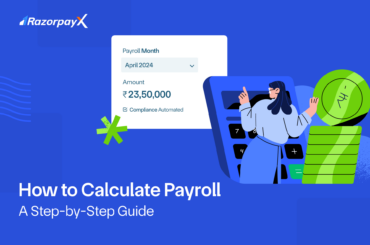Table of Contents
What is Employee State Insurance Scheme (ESI)?
The ESI or Employees State Insurance Scheme is an insurance cover provided to workers to aid them in uncertain and challenging times. It is a contributory fund governed by the Employee State Insurance Corporation and comes under the ESI Act, 1948.
This fund includes contributions from both employers and employees and provides insurance and cash benefits later.
As per the ESI Act, all establishments with more than 10 employees are covered under the ESI Act and have to maintain an ESI fund. All factories, shops and establishments are covered under the ESI Act unless otherwise specified by the Act. Also, employees are covered only if their salary is below Rs. 21,000 per month and the organisation is covered under ESI.
RazorpayX Payroll is India’s only fully automated payroll compliance solution – calculate & file statutory compliances like ESIC, PF, and PT with just one click.
How are Wages defined as per the ESI Act?
The ESI contribution of both the employer and the employee is calculated on the basis of the employee’s wages. To determine the eligibility and the wages on which ESI contribution should be calculated, some items are included, and some of the components are excluded.
Given below is the list of the items that should be included and excluded while doing ESI calculation on salary.
| Items Included | Items Excluded |
| Basic Pay | Entertainment Allowance |
| Dearness Allowance | Leave Encashment |
| City Compensatory Allowance | Compensation for Retrenchment |
| House Rent Allowance | Gratuity |
| Sales Commission | Deduction for Health Insurance Premium |
| Meal Allowance | Tax Deductions |
| Medical Allowance | Annual Bonus |
| Special Allowance and Overtime | Annual Commission |
| Newspaper Allowance | Petrol Allowance |
| Education Allowance |
Important Note: Regarding conveyance allowances
The Supreme Court has passed an order recently (dated 8 March 2021) stating that conveyance allowance or travel allowance does not fall under the definition of ESI wages. Hence, employers have to exempt conveyance allowance from ESI contributions and for computing the ceiling limit of Rs. 21,000 per month.
This is applicable to you only if you are using custom salary structures which include an allowance called “Conveyance Allowance”.
ESI Calculation
The ESIC act, 1948, has fixed the percentage contribution of the employer at 3.25% of the wages and that of the employee at 0.75% of the wages.
ESI Calculation Formula
ESI is calculated on total earnings every month (excluding any employer contribution to PF/ESI, if included in the employee’s CTC).
The wages are calculated by adding the basic pay and the Allowances (DA + HRA + Medical + City Compensatory Allowance, etc.).
How to Calculate ESI with Example
Let’s say the calculated wages of Mr X as per the ESI Act, 1948 is INR 20,000. Then the contributions will be calculated using the ESI calculation formula as below.
| Particulars | Calculation | Amount |
| Employer’s Contribution (@3.25%) | 20,000*3.25% | 650 |
| Employee’s Contribution (@0.75%) | 20,000*0.75% | 150 |
| Total Contribution | — | 800 |
After calculating the contributions and deduction of Rs. 150 from Mr X’s wages, the employer is responsible for depositing the total contribution, i.e., Rs. 800, to the corporation within the stipulated time.
Collection of ESI Contribution
The employer is required to pay his contribution as well as deduct the employee’s contribution of their salary every month. This amount of contribution (employer’s contribution + employee’s contribution) needs to be deposited with the corporation within 15 days of the last day of the month in which it was deducted.
SBI and some other banks have been authorised by ESIC (Employees’ State Insurance Corporation of India) to collect payments on its behalf.
What is Contribution Period and Benefit Period?
The ESI scheme divides the calendar year into two contribution periods of 6 months each. These contribution periods have a corresponding benefit period in the following year. In other words, for the contribution made during the first 6 months, the employee receives its benefits during the next 6 months (benefit period).
This provision benefits those employees whose salary increases above the threshold limit of Rs. 21,000 during the contribution period.
| Contribution Period | Benefit Period |
| 1st April to 30th September | 1st January to 30th June |
| 1st October to 31st March | 1st July to 31st December |
ESI in case of Salary Increase
Let’s say that the salary of Mr X was Rs. 18,000 in May 2021. It increased to Rs. 23,000 from June 2021. In this case, the ESI contribution of both the employer and the employee is calculated on 18,000 for April to May and on 23,000 from June to September.
This benefits the employees as they receive more contributions. But, after September, when the contribution period gets over, the employee becomes disqualified from the ESIC act.
However, the employee receives the benefit during the corresponding benefit period, i.e., 1st January to 30th June.
ESI Return Filing
The establishments registered under the ESIC Act, 1948 are required to file ESI returns. The employers can download Form 1 from ESIC’s official website in PDF format, fill it and submit it online.
Deadlines for Filing ESI
The deadline for filing ESI returns for both the periods is as follows –
- For the contribution period of 1st April to 30th September – 12th November
- For the contribution period of 1st October to 31st March – 12th May
Documents Required for ESI Registration
To ensure compliance under the ESIC Act, 1948 and ensure that employees avail its benefits, every establishment covered under the Act has to register with ESI in Salary. Following is the list of documents that are required to get registered under ESI.
- Address proof of the business
- Business PAN Card
- Details about shareholders, partners and directors.
- Business licences
- Employee details and the details of their salary structure.
- Bank account details
- Memorandum of Association, Article of Association, the partnership deed or other business deeds.
Penalties for Non-payment of Employee Contribution
- The employer is responsible for depositing the employee as well as the employer’s contribution with ESI in salary.
- If the employee’s contribution is deducted from their salary but not paid by the employer is considered a punishable offence under the ESI act.
- Any non-payment, late payment or false payment can attract a penalty of Rs. 5000 and up to 2 years in prison.
Automate ESI calculation & filings
RazorpayX Payroll automates the calculation & filing of statutory compliances like ESIC, PF, PT and more. It is an all-in-one HR & payroll software that helps a company manage their employees and compliances in just 3 clicks.
And, here are a few other benefits of RazorpayX Payroll:
- Customised offer letters for onboarding employees
- Automatic CTC calculation and payroll calculation while taking into account the statutory deductions like TDS, PF, ESI etc.
- Tax calculation and filing for your company on respective govt. portals
- Group health insurance for teams as small as 2!
- Flexi Benefit Plan and integrations with other leading software
- Attendance and leave management system
[Read how Zo World Reduced Its Payroll & Reimbursement Timelines by 75% with RazorpayX Payroll]
Read more:
FAQs
1. How is ESI calculated from salary?
The wages are calculated by adding the basic pay and the Allowances (DA + HRA + Medical + City Compensatory Allowance, etc.). Please refer to the example in the blog post for more details.
2. What is the ESI limit?
Rs. 21,000 is the threshold for wages under the Employees State Insurance Act, 1948. This amount is calculated by adding basic pay and allowances like HRA, DA, Medical allowance, and commission.
3. How do I calculate ESI?
ESI is calculated on the gross salary paid to the employees. As per the ESI Act, the employer contributes 3.25% of the wages, and the employee contributes 0.75% of the wages to the contributory fund, which is then used to provide insurance cover to the employees in difficult times.
4. What are the benefits of ESI?
The benefits of ESI are as follows: 1. Sickness benefit at 70% of wages for a maximum of 91 days is provided in the case of medical leave 2. Medical coverage for employees and their families 3. Cash benefits for pregnant women 4. 90% of wages are paid to dependents if the employee dies on the job 5. Cash benefits for a maximum of 24 months in case of temporary and lifetime in case of permanent disablement on the job





